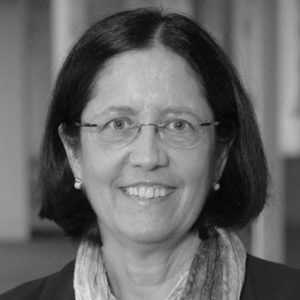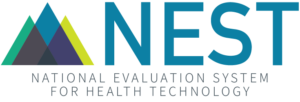Conversation with the NESTcc Governing Committee Member: Kathleen Blake, MD, MPH
 “There is nothing more exciting than seeing people we care for and care about experience better health and everything that goes along with it. It is a privilege to be able to be a part of that journey.”
“There is nothing more exciting than seeing people we care for and care about experience better health and everything that goes along with it. It is a privilege to be able to be a part of that journey.”
Kathleen (Kathy) Blake, MD, MPH
Vice President of Healthcare Quality at the American Medical Association
Dr. Kathleen Blake embodies the clinician’s devotion to their patients.
She began her career as a clinical cardiac electrophysiologist, implanting cardiac devices in patients and following their short-term and long-term progress after the procedure. Her interest in this field developed partly because her mother was an early recipient of an artificial heart valve, living 24 years longer than expected because of that medical technology. In her current role at the American Medical Association, Kathy continues to focus on the quality and performance of medical devices, paying close attention to how they (most often) improve and yet unfortunately sometimes have a negative impact on the health outcomes of patients.
When individual patients come in with a potential device safety or performance issue, it is sometimes difficult to determine whether those issues represent normal wear and tear or a generalizable problem related to product design. Even if clinicians and their health systems collect their own data, the sample size available to them may be limited by the size of their community and insights limited by the ability of their IT systems to share and combine data with those of other organizations.
“Clinicians who implant medical devices want to know that the device that they are about to put into an individual is well-tested and understood so that the person receiving it has the best possible chance of a good outcome. If a problem is starting to crop up with a particular device or class of devices, and is verified, we want to know that as soon as it is reasonably possible,” Kathy said.
That knowledge obviously also impacts the care of patients who already have the device – they may need to be evaluated more frequently or extensively and, in some instances, have the device removed. Access to such information is also critical to those individuals who do not yet have the device but might receive it during the time that it takes for manufacturers and regulators to analyze, confirm, and relay safety information to the clinician community. Despite the importance of timely access to such information, current processes for gathering and analyzing data and disseminating findings are slow and fragmented.
Kathy hopes that NESTcc will shorten the time from when a bona fide device problem is first detected to when it is communicated so that as few people as possible receive the device during that window of time. Her hopes echo FDA’s continued support of NEST and NESTcc to “establish a robust medical device patient safety net in the United States,” as outlined in the agency’s April 2018 Medical Device Safety Action Plan.
Dr. Blake was a member of the planning board that made the recommendation to establish NEST. She believes that the timing is right for NEST to succeed because of the investments that have been and will continue to be made to expand the nation’s electronic health records infrastructure and to build the capacity and capabilities needed to evaluate medical devices using large data sets and new methods throughout the total product life cycle.
“It’s as if we are moving past the very basic Model T Ford – we’ve got the road, the cars, the gas stations, experienced drivers, and a licensing system – but we are not yet going very fast or very far. NESTcc is the ‘vehicle’ that will take those basic components and carry us faster and farther, getting us beyond paper records, out of silos, and to a network for information sharing for all medical devices throughout their full product life cycles. The Governing Committee is comprised of 15 individuals with diverse perspectives and capabilities. Its composition is a source of its strength and a reason for optimism. NEST is being built to make progress faster and to do better than any of us, or our organizations, could ever have done alone,” she said.
How Clinicians Can Help Support the Efforts of NESTcc
One of Kathy’s goals as the representative of clinician organizations is to familiarize clinicians with NESTcc, especially those who may not see its immediate relevance to their practices and patients.
“As a cardiologist, I took care of thousands of patients, and I knew there were gaps in what I knew and what I was able to offer. NEST is a way – at a national level – to fill those gaps. Once NEST is fully operational and is being used by its many stakeholders, clinicians should expect to have more knowledge about and greater confidence in the medical devices they recommend to their patients and be better able to manage any challenges that might arise,” she said.
Looking forward, she is optimistic that NESTcc may also help identify patient subgroups, such as “super responders” to device therapy or, alternatively, patients who are unlikely to respond to a device and should not receive it. NEST aims to provide clinicians and patients with the information they need to make better decisions. NESTcc’s clinician researchers and Network Collaborators are now laying the groundwork to receive and answer queries, such as those related to subgroups, at any stage of the total product life cycle (TPLC). Kathy expects that the results of the NESTcc demonstration projects and test-cases will build clinician confidence in information based on real-world evidence generated by collaboration with NESTcc.
Kathy is passionate about communicating NESTcc’s efforts and soliciting stakeholder input. She encourages clinician associations to engage with NESTcc and provide feedback on how and in what format clinicians want to receive information from NESTcc.
“We have stakeholders out there who are waiting to see if we can pull this off. I want to be sure as many people as possible know that there is an opportunity for them to participate. I want the projects to have the best chance of success because then we get to goal – which is getting better information more quickly into the hands of those who need it. For me, it’s about seeing that full cycle from planning NEST and creating its infrastructure and capabilities to producing results. That’s what I’m passionate about,” she said.
Hear Kathy share her passion for the potential of NESTcc for clinicians and patients at the upcoming NESTcc panel session at the 2018 International Society for Pharmacoeconomics and Outcomes Research (ISPOR) Conference.
Related Links
Governing Committee Spotlight: Michelle McMurry-Heath, Ph.D. – Interim Chair
Governing Committee Spotlight: Vance Moore
This blog was written by Marina Damiano, Ph.D., as a contributing member of the NESTcc communications team.
